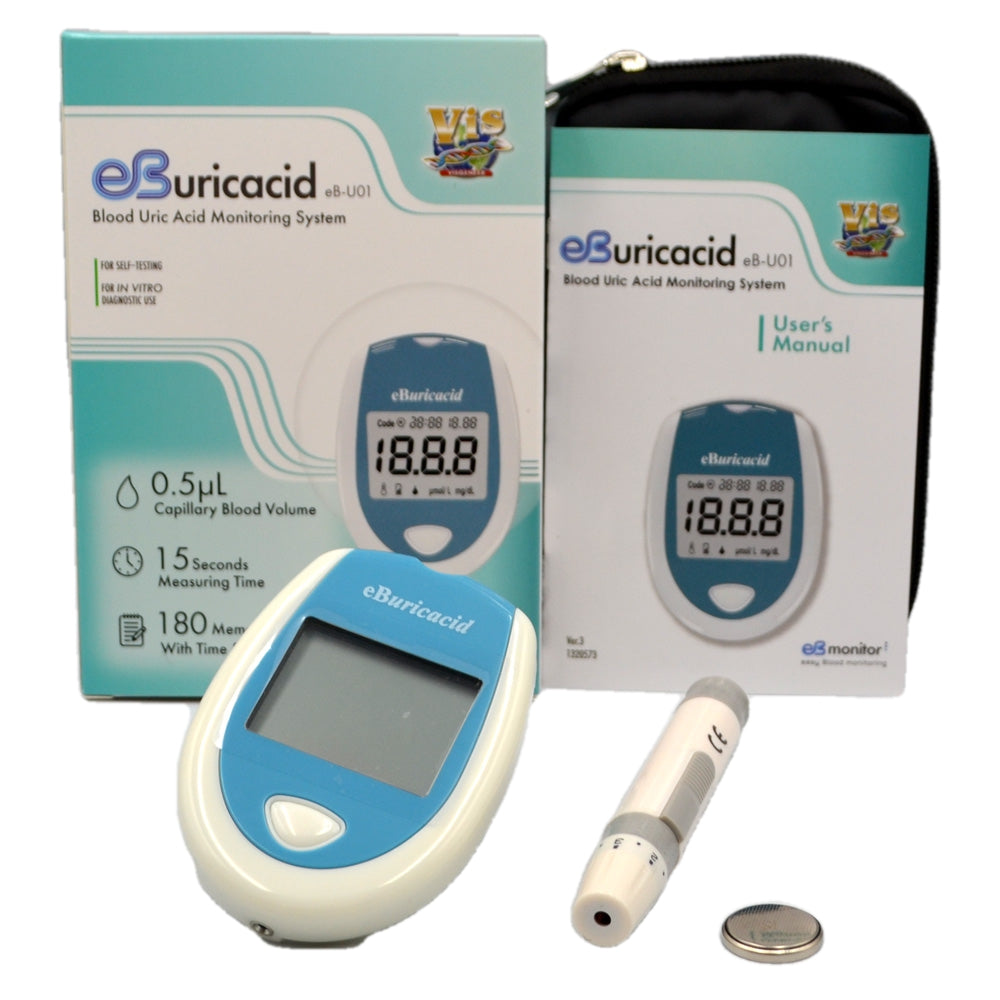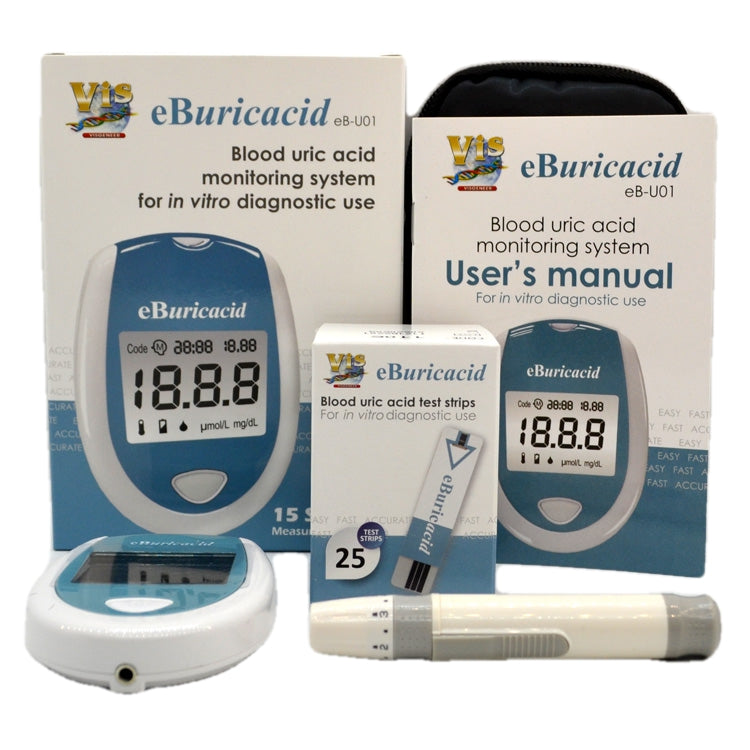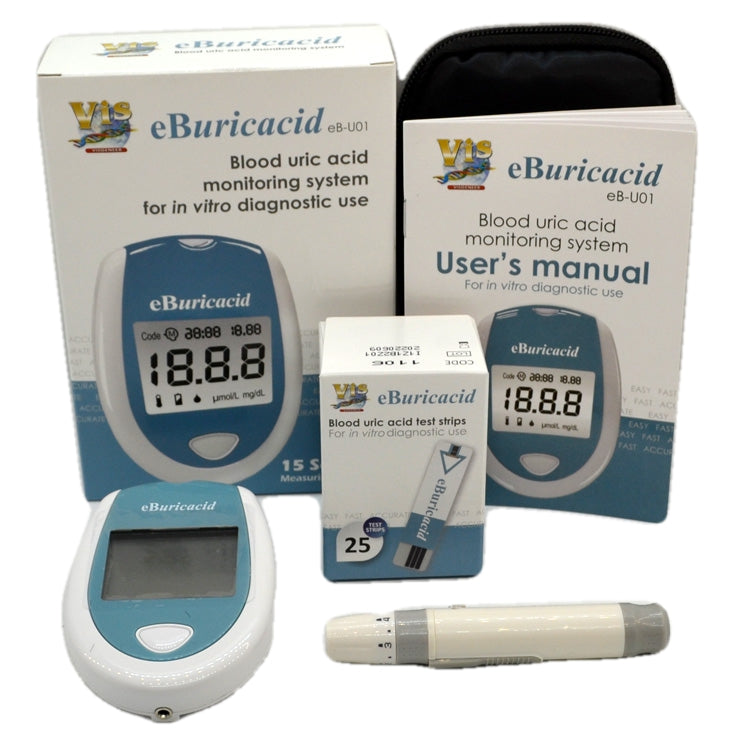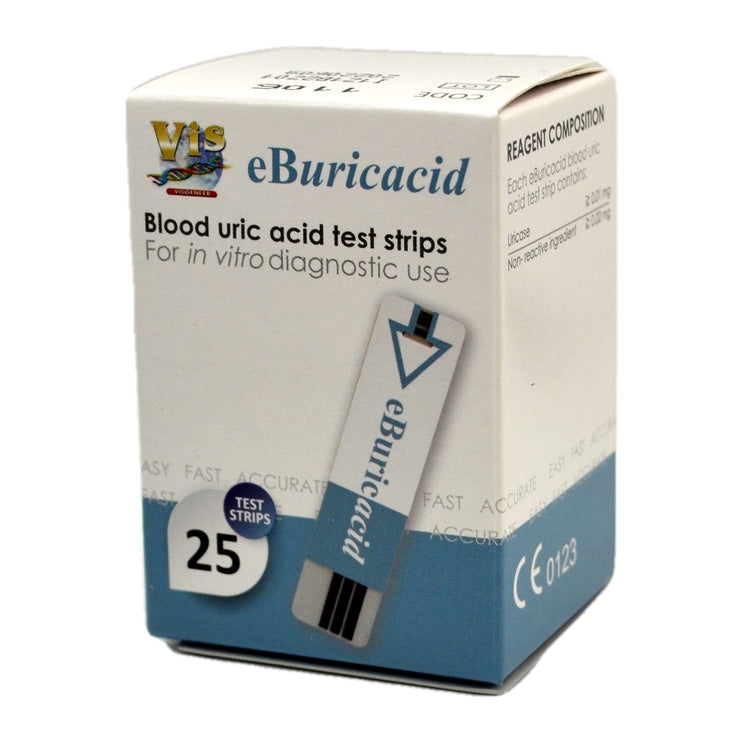Valuemed
eBuricacid Blood Uric Acid Meter
eBuricacid Blood Uric Acid Meter
Couldn't load pickup availability
eBuricacid uric acid meter for blood uric acid level testing
- Fast, accurate and easy to use eBuricacid eB-U01 uric acid meter
- Blood uric acid meter for monitoring uric acid levels
- eBuricacid meters allow fast, reliable and accurate measurement of real-time blood uric acid levels micro mols per litre (umol/l) or grams per decilitre (g/dL)
- This uric acid meter is easy enough for home and self-testing of uric acid levels in blood when monitoring gout and accurate enough for professional health screening use.
- This uric acid meter is accurate enough for professional clinic testing by GP's nurse specialists, out patients and health screening professionals
- The uric acid meter works with eBuricacid blood uric acid tests strips
- Manufactured by eBwell
Uric acid meter pack contents:
- Blood uric acid meter and battery
- Warranty card
- Lancing device
- 10 lancets
- Users manual
- Choose the pack with either 25 or 50 uric acid test strips + 25 or 50 lancets
Why buy the eBuricacid uric acid meter?
- The eBuricacid uric acid meter is very easy to set up and use, just insert a strip and it's ready to go.
- Only needs a tiny blood sample 0.5uL to test
- Results in just 10 seconds on a large clear display
- Meter holds 180 results with time and date
- Supplied with 3v Lithium battery in the box
- Comes with a well-written user guide with tips and a troubleshooting section
- Full UK 12 month warrantee and UK based (office hours) technical support.
- Uric acid meters and uric acid test strips supplied from UK stock with a supply promise to ensure the longevity of your meter
How accurate is the eBuricacid uric acid meter?
- The eBuricacid uric acid meter is calibrated using the RANDOX RB1007 assay by Hitachi 704 automatic analyzer against capillary blood samples to meet industry standards of no more than 6% variance compared to laboratory whole blood samples.
- This means you can expect reliable blood uric acid test results comparable to laboratory uric acid tests when using this uric acid meter.
- A control solution pack is NOT included in the UK starter packs as there is no need to run a control solution test during the commissioning of a new meter. calibration is provided on the code chip provided with each pack of test strips.
Uric acid meter video demonstration, with tips on how to get good blood samples for accurate test results
Share
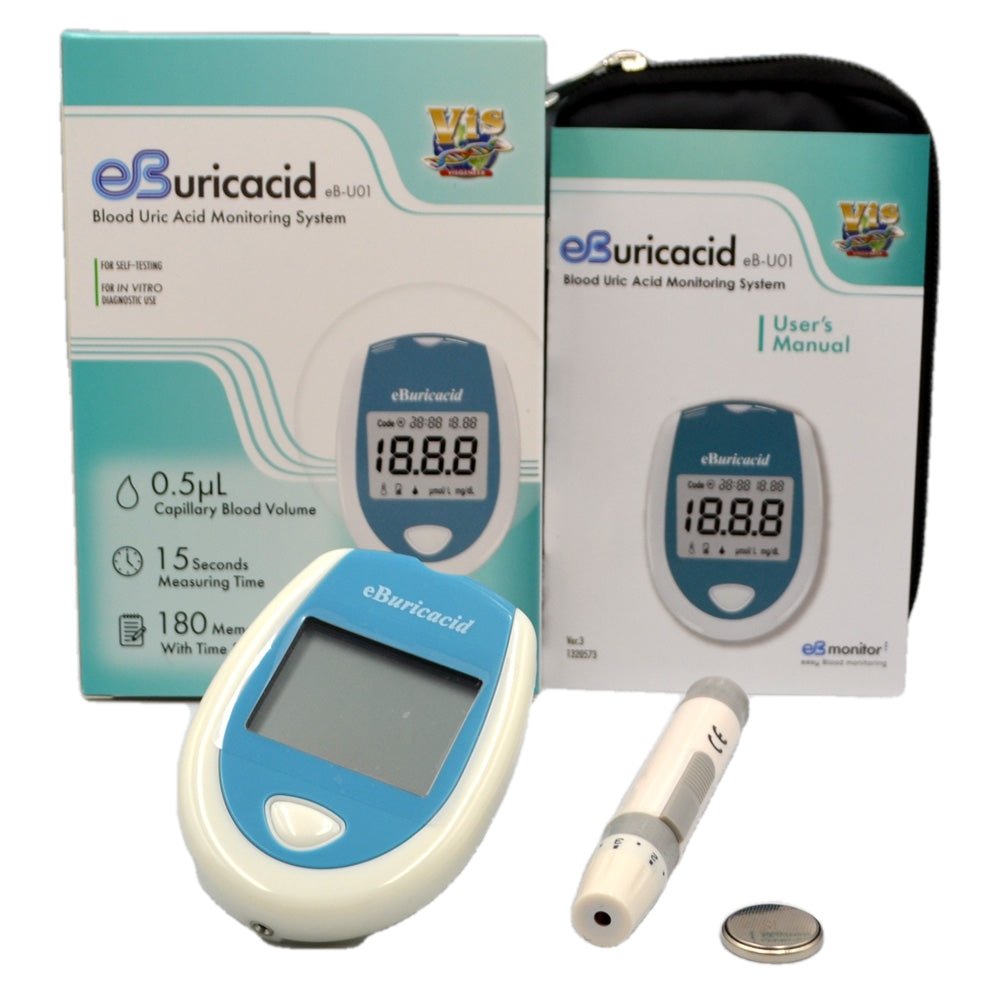
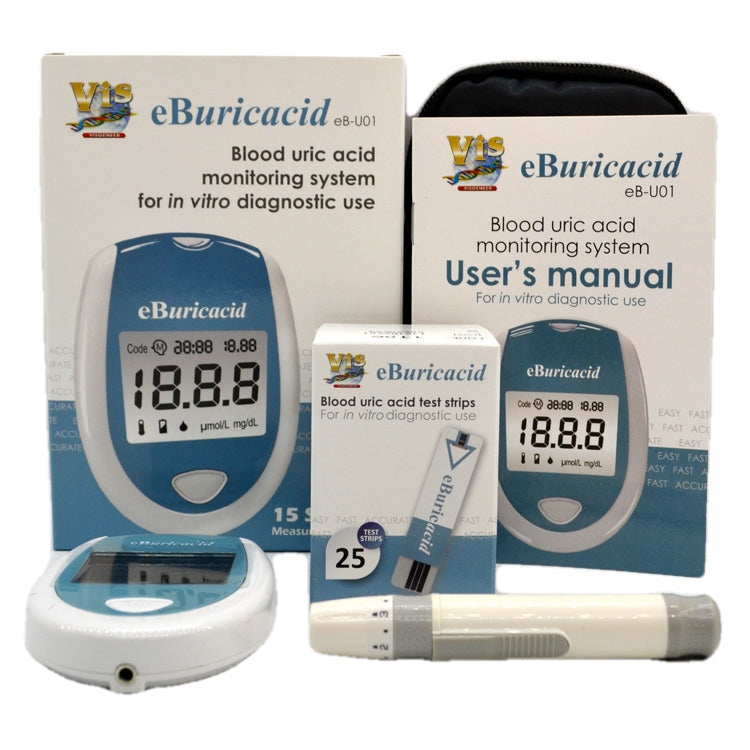
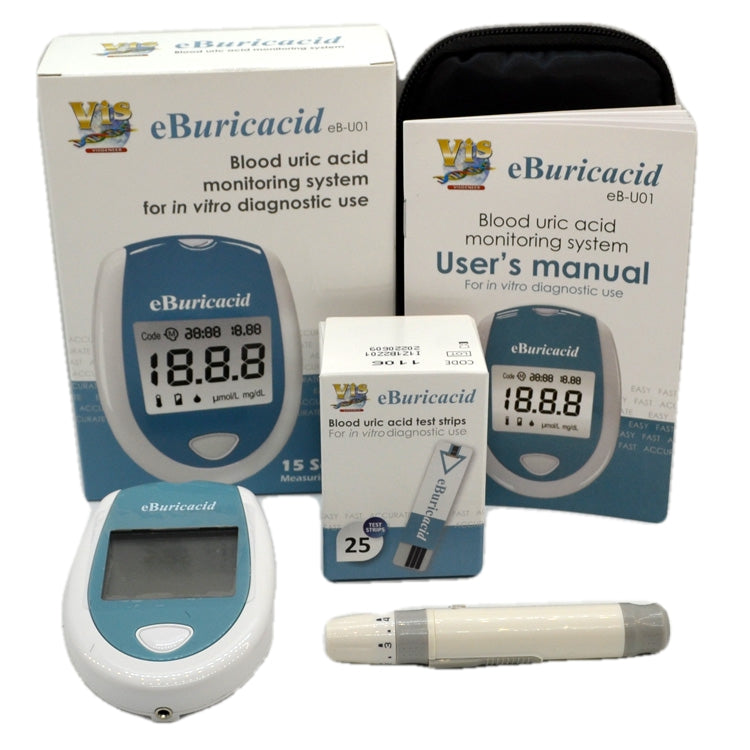
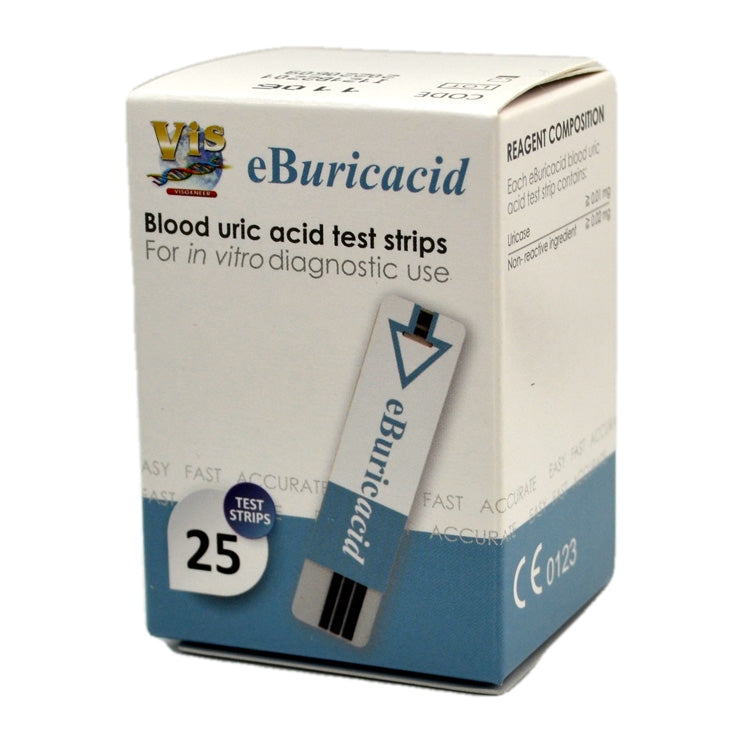
Collapsible content
Can I check my uric acid level at home?
It's now possible to check your uric acid levels at home using commercially available uric acid test kits and a meter. It's important to note that these uric acid tests may not be as comprehensive as those conducted in a clinical laboratory, but they are a very useful tool to monitor your uric acid levels.
What are normal Uric Acid Levels?
Here are the normal blood ranges for Uric Acid.
Adult Males between 200 – 430 umol/L
Adult Females between 140 – 360 umol/L
Uric acid (urate) is produced during the breakdown of purines and excreted in both urine and faeces. Not everyone with elevated uric acid gets gout, only if crystals form in synovial joints.
Reasons to measure uric Acid
Uric acid can be elevated in pregnancy (uric acid may be measured while investigation/monitoring pre-eclampsia) during chemotherapy and radiotherapy. Uric Acid is also monitored in cases of renal failure and Liver disease resulting from excessive use of alcohol, starvation. Other rarer causes of high uric acid include a high-protein diet and strenuous exercise. Elevated levels are also seen in the rare inherited disorder, Lesch-Nyhan syndrome.
Low uric acid levels also occur in severe liver disease, low protein diet, heavy metal poisoning, Wilson's disease, and some cancers.
Some drugs will affect uric acid levels. These include, raised levels caused by thiazide diuretics, theophylline and low-dose aspirin;
Low blood Uric Acid levels can occur with high-dose aspirin, corticosteroids, and allopurinol.
How do you prepare for a uric acid blood test?
No special preparation is required for a uric acid test. You do not need to fast and it can be done at any time of day, although a fasted uric acid test first thing in the morning will usually give you the most consistent results, as food intake, exercise and fluid intake can affect the uric acid levels later in the day.
Does high uric acid levels run in families?
Yes, there is a genetic component to high uric acid levels, and the risk of hyperuricemia (elevated uric acid in the blood) and gout tends to run in families. If one or more close relatives, such as parents or siblings, have a history of gout or elevated uric acid, your risk of experiencing similar issues may be higher.
Genetics can influence how the body processes and eliminates uric acid. Variations in genes related to purine metabolism and uric acid excretion by the kidneys can contribute to the development of hyperuricemia. However, it's important to note that genetics is just one factor, and environmental factors, diet, lifestyle choices, and overall health also play crucial roles.
If there is a family history of gout or hyperuricemia, it may be wise to be proactive in managing lifestyle factors that can influence uric acid levels. This includes maintaining a healthy weight, staying hydrated, avoiding excessive alcohol consumption, and making dietary choices that minimise the intake of purine-rich foods.
What foods increase uric acid levels in the blood?
Certain foods are known to be high in purines, which can increase the levels of uric acid in the blood. High levels of uric acid can contribute to conditions like gout. It's important to note that individual responses to specific foods can vary, and not everyone will be affected in the same way. Here are some foods that are generally considered to be high in purines:
- Organ meats: Liver, kidneys, and other organ meats tend to be high in purines.
- Certain seafood: Some types of seafood are rich in purines. Examples include anchovies, sardines, mussels, scallops, and trout.
- Red meat: Beef, lamb, and pork can contribute to higher purine levels.
- Game meats: Meats from game animals like venison and rabbit can be high in purines.
- Processed meats: Certain processed meats, such as hot dogs and sausages, may contain higher levels of purines.
- Alcohol: Beer and spirits, especially beer, have been associated with an increased risk of gout due to their purine content.
- Certain vegetables: While most vegetables are low in purines, some high-purine vegetables include asparagus and spinach. However, the purine content in vegetables is generally lower compared to meat and seafood.
Are there any foods that can reduce uric acid levels in the blood?
If you're looking to reduce uric acid levels, incorporating certain foods into your diet and adopting a healthy lifestyle can be beneficial. Here are some foods and dietary practices that may help lower uric acid levels:
- Cherries: Some studies suggest that cherries and cherry juice may help reduce uric acid levels and decrease the frequency of gout attacks.
- Berries: Berries, such as strawberries, blueberries, and blackberries, are rich in antioxidants and may have anti-inflammatory effects.
- Apples: Apples contain malic acid, which may help neutralise uric acid and contribute to its elimination from the body.
- Citrus fruits: Citrus fruits like oranges, lemons, and grapefruits contain vitamin C, which may help lower uric acid levels.
- Low-fat dairy products: Low-fat dairy, such as milk, yogurt, and cheese, may help lower uric acid levels. Some studies suggest that the proteins in dairy products may have a protective effect against gout.
- Vegetables: Most vegetables are low in purines, and some, like kale, cabbage, and broccoli, may have anti-inflammatory properties.
- Whole grains: Foods like whole wheat, brown rice, and oats are high in fiber and may help regulate uric acid levels.
- Water: Staying well-hydrated is crucial for flushing out uric acid from the body. Aim to drink plenty of water throughout the day.
- Coffee: Some studies suggest that moderate coffee consumption may be associated with a lower risk of gout. However, individual responses can vary.
- Herbs and spices: Some herbs and spices, such as turmeric and ginger, have anti-inflammatory properties and may be beneficial.
How do you lower uric acid levels naturally?
Lowering uric acid levels naturally involves making lifestyle and dietary changes. Here are some tips that may help reduce uric acid levels:
- Hydration: Drink plenty of water to help flush out uric acid from the body. Aim for at least 8 glasses (64 ounces) of water per day, and more if you are physically active or live in a hot climate.
- Limit purine-rich foods: Reduce intake of foods high in purines, such as organ meats, seafood (especially anchovies and sardines), red meat, and certain vegetables (like asparagus and spinach). Instead, focus on a well-balanced diet that includes a variety of fruits, vegetables, whole grains, and lean proteins.
- Cherries: Some studies suggest that cherries and cherry juice may help lower uric acid levels. Consider incorporating fresh cherries or unsweetened cherry juice into your diet.
- Berries: Include berries like strawberries, blueberries, and blackberries in your diet. They are rich in antioxidants and may have anti-inflammatory effects.
- Low-fat dairy: Consuming low-fat dairy products, such as milk, yogurt, and cheese, may help lower uric acid levels. The proteins in dairy may have a protective effect against gout.
- Vitamin C: Foods rich in vitamin C, such as citrus fruits, bell peppers, and strawberries, may help lower uric acid levels. Consider incorporating these foods into your diet or taking a vitamin C supplement after consulting with a healthcare professional.
- Coffee: Some studies suggest that moderate coffee consumption may be associated with a lower risk of gout. However, individual responses can vary, and excessive caffeine intake should be avoided.
- Maintain a healthy weight: Losing excess weight can help lower uric acid levels. However, avoid crash diets, as rapid weight loss can temporarily increase uric acid levels.
- Limit alcohol: Alcohol, especially beer, has been linked to higher uric acid levels. Limit alcohol consumption or avoid it altogether, particularly if you have gout.
- Regular exercise: Engage in regular physical activity to help maintain a healthy weight and improve overall well-being. However, avoid intense exercise during gout flares.
Why is my uric acid high but I have no gout symptoms?
Elevated uric acid levels without the presence of gout symptoms is a situation known as hyperuricemia. Hyperuricemia occurs when there is an excess of uric acid in the blood. While gout is one of the conditions associated with high uric acid levels, not everyone with elevated uric acid will develop gout.
It's important to note that even without gout symptoms, persistently high uric acid levels may have implications for long-term joint health and could potentially contribute to other health issues. Regular monitoring and consultation with a healthcare professional are recommended, especially if you have risk factors for gout or other related conditions.
Are uric acid home tests accurate?
This home uric acid test meter and strips is 97% accurate when compared to a laboratory uric acid. The meter tests a small blood sample obtained from a finger prick, to measure uric acid levels, whereas a laboratory test performed by your doctor will usually be done on a larger blood sample, obtained by venepuncture. The lab uric acid tests will usually be more comprehensive as the test is performed on a much larger blood sample, so it is still worth having your levels checked with your doctor from time to time.
When is the best time of day for a uric acid test?
For the most accurate and consistent readings of your blood uric acid levels, testing in the morning after an overnight fast is generally recommended. This approach minimizes the influence of dietary and physiological variations throughout the day.
Very easy and also accurate I have found the meter and strips work well and having the readings to hand in the meter makes it easy to see how the uric acid levels change over time
Thank you for your review of the uric acid meter Terry. We are really pleased to hear that the meter and test strips are working well for you. If you need any assistance, please do not hesitate to contact our customer support team.
Kind regards
Valuemed Team
"I was advised by my GP that my uric acid level was high. 470 was last GP result, safe range is 200 - 430, but I was advised to try to get it down to <300. So, as I can't keep going to the GP for tests, so I did some research, this meter looked ideal. Arrived promptly. I have not used a device like this before. There are 2 videos on the ValueMed website which explained the basics. I got to the stage of taking the blood sample. There is no video on the site that explains this, so I rang Customer Services. The service was excellent, a kind lady called Helen guided me through the process. In fact there is a video that shows how to lance, although the meter is an Easylife meter and the test is for cholesterol, the process is the same. I would suggest that the link to that video is added to the other two videos on the ValueMed page. My initial thought was "this is a bit of a faff". I also had a bit of trouble getting the blood sample on the Test strip as...err...I am a bit clumsy. If you follow the procedure in the lance video, you insert the Test Strip into the meter first, then get the blood sample, and touch the test strip at the end, it took 3 or 4 attempts. What seemed a faff is now really easy. Only other thing is when you open a new batch of test strips, you need to check that the batch number which is on the box is the same batch number that displays on the meter when you first insert a Test Strip, you only need to do this once per batch.”

